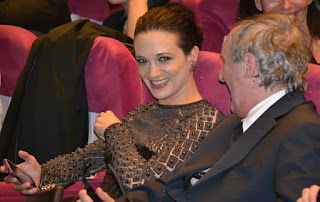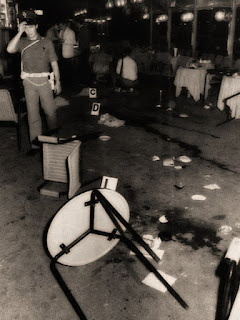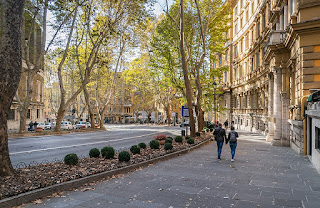Twice winner of Italian ‘Oscar’ with turbulent private life
The actress and director Asia Argento, whose father is the influential horror movie director Dario Argento, was born on this day in 1975 in Rome.
Asia Argento pictured with her father, the celebrated
horror film director, Dario Argento, at Cannes in 2012
Argento’s mother was the actress Daria Nicolodi, granddaughter of the composer Alfredo Casella. She appeared in her first movie at the age of nine and turned out to have such a talent for acting she had won two David di Donatello best actress awards - the Italian equivalent of an Oscar - by the time she was 21.
As well as appearing in around 50 movies, some of which she also wrote and directed, and a number of television productions, Argento’s artistic talents have ranged to writing short stories and novels and recording solo albums as a singer.
Her private life has been somewhat turbulent. Married for five years to the director Michele Civetta, she was previously in a long-term relationship with the Italian rock musician Morgan, and later became romantically involved with the celebrity chef and documentary maker Anthony Bourdain, who took his own life at the age of 61.
 |
| Argento was a key figure in the film industry's #MeToo movement |
In 2018 she found herself at the heart of another sexual scandal, this time as the alleged perpetrator, when the New York Times reported claims from Jimmy Bennett, who had worked with Argento as a child actor, that he had been assaulted by her in a hotel room in California at the age of 17, below that state’s age of consent. Argento denied the allegation, although later reached a financial settlement with Bennett.
Argento’s first name appears in the records of the Rome register office as Aria after “Asia” was deemed inappropriate by officials at the time, although she has never been known as anything else. She claimed she took up acting in an attempt to grab her father’s attention during a childhood in which she said he was often absent because of work.
It worked. Two of her first three parts were in films produced by her father, who then directed her in a starring role in his 1993 horror-mystery Trauma.
Within a year, Argento had landed the first of her David di Donatello awards as best actress for her portrayal of a paraplegic in Perdiamoci di vista - roughly translated as 'Let’s Not Keep in Touch' - a bittersweet comedy directed by Carlo Verdone, who also co-stars.
Three years later, a second David di Donatello for best actress came her way after she starred in American director Peter del Monte’s drama Compagna di Viaggio - Travelling Companion - as a waitress who is asked by a friend to shadow her father, who has memory problems.
_(cropped).jpg) |
| Argento has combined her acting career with music |
She won a Nastro d’Argento award - the prestigious award made by Italian film journalists - for the 2014 production, Incompresa - Misunderstood - which she directed and co-wrote.
A fluent English speaker, she became known to wider cinema audiences through starring in the 2002 Hollywood blockbuster, xXx, directed by Rob Cohen, in which she played an undercover spy, appearing alongside Vin Diesel and Samuel L Jackson, and landed a number of Hollywood roles as a consequence, before returning to the European cinema scene.
Alongside her film career, she is heavily involved with music. A singer with a deep, intense voice, she collaborated with a number of musicians in different genres, from traditional ballads to experimental new wave and techno rock. So far, she has released eight singles and two studio albums as well as appearing as a guest performer with other artists.
Her many TV appearances include participation in the 11th edition of Ballando con le Stelle - the Italian equivalent of America’s Dancing with the Stars and the UK’s Strictly Come Dancing - in which she was eliminated in week eight.
Argento published an autobiography, Anatomia di un cuore selvaggio (Anatomy of a Wild Heart), in 2021. She has two children, a daughter from her relationship with Morgan and a son by Michele Civetta, with whom she reportedly lives in the Vigna Clara neighbourhood to the north of Rome’s city centre.
In 2022, after taking a step back from films for a number of years, Argento made a comeback, again directed by her father, in Dark Glasses, a dark thriller in which she plays the guardian of a blind woman being hunted by a psychotic killer.
Dario Argento’s standing among horror movie fans is such that, in 1989, he opened a memorabilia shop in Via dei Gracchi, a short distance from the Vatican and Castel Sant’Angelo in the heart of Rome. Named Profondo Rosso (Deep Red) after the title of one of Argento’s most popular films, which starred David Hemmings and Argento’s wife, Daria Nicolodi, it is a small premises crammed to the rafters with rubber masks, costumes, props, posters and model figures. It is also the home of Argento’s Museum of Horror, a red-painted basement accessed via a door next to the till, containing model reconstructions of famously gory scenes from his extensive back catalogue.
Travel tip:
The historic Ponte Milvio is one of the Rome
attractions accessible on foot from Vigna Clara
Vigna Clara, where Asia Argento has a home, is a pleasant neighbourhood to the north of the historical centre of Rome, reached by crossing the Tiber via the Ponte Flaminio and proceeding north about 1.5km (1 mile). It has a lively commercial centre with good amenities and several public parks, while the residential streets comprise elegant buildings and upmarket villas. It offers access on foot to tourist attractions such as the historic Ponte Milvio, the Stadio Olimpico and the Auditorium Parco della Musica. It is a 15-minute train ride from the Vatican, while the main city centre attractions are about 40 minutes away by train and metro. The neighbourhood's church of Santa Chiara a Vigna Clara, designed by Alberto Ressa and opened in 1962, is unusual for having a circular layout.
Also on this day:
1378: Election of Pope Clement VII
1870: Rome’s walls breached in final act of unification
1934: The birth of actress Sophia Loren
.jpg)
.jpg)





.jpg)





.jpg)
.jpg)


.jpg)
.jpg)
.jpg)








.jpg)
%20(1).jpg)
